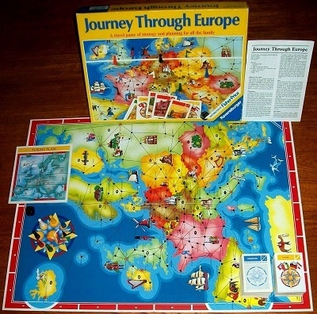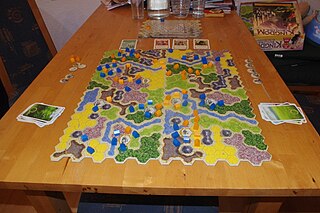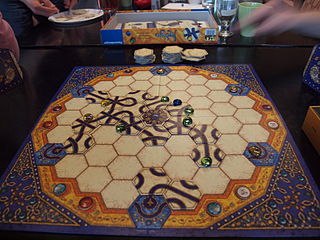
Upwords is a board game. It was originally manufactured and marketed by the Milton Bradley Company, then a division of Hasbro. It has been marketed under its own name and also as Scrabble Upwords in the United States and Canada, and Topwords, Crucimaster, Betutorony, Palabras Arriba and Stapelwoord in other countries. It is currently available as a board game and a digital gaming app.

Scotland Yard is a board game in which a team of players controlling different detectives cooperate to track down a player controlling a criminal as they move around a board representing the streets of London. It was first published in 1983 and is named after Scotland Yard which is the headquarters of London's Metropolitan Police Service in real-life. Scotland Yard is an asymmetric board game, during which the detective players cooperatively solve a variant of the pursuit–evasion problem. The game is published by Ravensburger in most of Europe and Canada and by Milton Bradley in the United States. It received the Spiel des Jahres award in 1983, the same year that it was published.

El Grande is a German-style board game for 2-5 players, designed by Wolfgang Kramer and Richard Ulrich, and published in 1995 by Hans im Glück in German, by Rio Grande Games in English, and by 999 Games in Dutch. The game board represents renaissance-era Spain where the nobility fight for control of the nine regions. El Grande was praised for its area-control mechanism, and was awarded the Spiel des Jahres prize and the Deutscher Spiele Preis in 1996. Following its release, several expansions and an alternative version were published.

TransAmerica is a railroad board game centered on the construction of railroad track in the United States. The game was created by Franz-Benno Delonge and developed by Team Annaberg. It is published in the United States by Rio Grande Games. In 2003 it was a Mensa Select recipient, and was nominated for the 2002 Spiel des Jahres award.
Scrabble variants are games created by changing the normal Scrabble rules or equipment.

Caylus is a strategy oriented, German-style board game designed by William Attia and independently published in 2005 by Ystari in France and England, and Rio Grande Games in North America. Caylus has a mix of building, producing, planning, and bargaining — without direct conflict or dice-rolling mechanics.

Journey through Europe or Explore Europe is a family board game in which the players travel around a map of Europe, rolling a die to move. When they have reached all their objective cities, they try to return home to win.

Take It Easy is an abstract strategy board game created by Peter Burley. It can be characterized as a strategic bingo-like game, and has been published by Ravensburger and subsequently by several other publishers since 1983.

The Princes of Florence is a German board game designed by Wolfgang Kramer and Richard Ulrich published in 2000 by Alea in German and by Rio Grande Games in English. Players assume the roles of Florentine Princes who wish to design their own villas to allow artists to create great works of prestige. Through seven rounds, each containing an auction phase and two action phases, the Princes pay for landscaping, buildings, freedoms, and various services and bonuses. At the end of the seven rounds, whoever has the most Prestige Points wins.
Manhattan is a board game designed by Andreas Seyfarth. In the game, players aim to construct and control skyscrapers that will award points. Manhattan received generally positive reviews and won the 1994 Spiel des Jahres award.

Agricola is a Euro-style board game created by Uwe Rosenberg. It is a worker placement game with a focus on resource management. In Agricola, players are farmers who sow, plow the fields, collect wood, build stables, buy animals, expand their farms and feed their families. After 14 rounds players calculate their score based on the size and prosperity of the household.

Kingdom Builder is a strategy board game designed by Donald X. Vaccarino, published in 2011 by Queen Games with illustrations by Oliver Schlemmer in German, British and international versions.

King of Tokyo is a monster movie-themed tabletop game using custom dice, cards, and boards, designed by Richard Garfield and released in 2011. A New York City-based edition, King of New York, was published in 2014. The game was re-released in 2016, with all-new artwork and characters.

The Castles of Burgundy is a board game for two to four players, set in Medieval Burgundy. It was designed by Stefan Feld and illustrated by Julien Delval and Harald Lieske, and was published in 2011 by Ravensburger/alea. It is considered a classic of the Eurogame genre, and is cited as one of the most influential board games of the last decade. It uses dice rolling and dice placement, a modular setup, and set collection as its mechanics. The dice and the ability to change them give players a wide range of options.

Russian Railroads is a tile-based Euro-style board game for 2 to 4 players by Helmut Ohley and Leonhard Orgler. The game was published in 2013 by Hans im Glück Verlag. It is based on the worker placement principle, in which players can in turn distribute their available workforce in open fields in order to gain resources or other benefits. This gameplay is also used in other games of the publishing house, such as Stone Age or Egizia.

Indigo is a 2012 tile-laying board game developed by Reiner Knizia and published by Ravensburger.

Azul is an abstract strategy board game designed by Michael Kiesling and released by Plan B Games in 2017. Based on Portuguese tiles called azulejos, in Azul players collect sets of similarly colored tiles which they place on their player board. When a row is filled, one of the tiles is moved into a square pattern on the right side of the player board, where it garners points depending on where it is placed in relation to other tiles on the board.

G.O.O.T.M.U. is a board game that was published by Jolly Games in 1992.
Viticulture is a worker placement board game published by Stonemaier Games in 2013. The game's design was crowdfunded via a campaign on Kickstarter, with the concept of players building an Italian vineyard. Upon its release, Viticulture received praise for its engagement, but its luck was critiqued. Several expansions and reprints were later released.
Flamecraft is a card game designed by Manny Vega which was fundraised via Kickstarter and published in 2022 by Cardboard Alchemy featuring illustrations by Sandara Tang. Players act as "Flamekeepers", assisting shops in town with dragons and enchantments in order to have the best reputation by the end of the game.
















